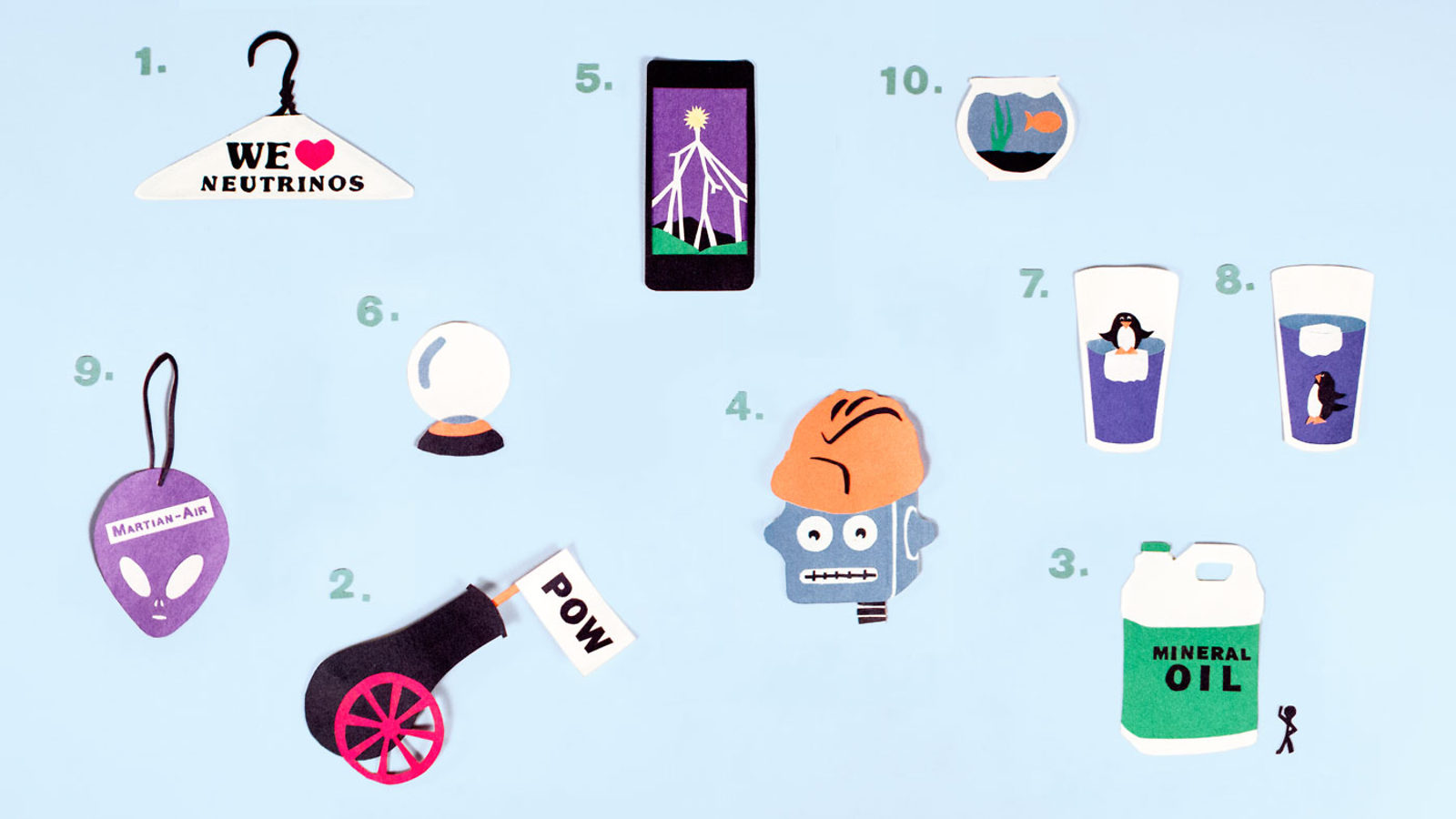Hans had been waiting in the darkened room for 45 minutes. It was a dull part of his day, but acclimating his eyes was a necessary part of his experiment—counting faint sparkles of light caused by alpha particles deflecting off a thin metal foil.
The experiment was part of a series organized by Ernest Rutherford in 1908, and it led to the discovery of the atomic nucleus. Rutherford’s assistant, physicist Hans Geiger, would share credit for the discovery.
Their experiment was particle physics in its infancy.
Studying particle physics requires revealing the smallest bits of matter. This work might involve hurling billions of accelerated particles at a target and watching for the flash of energy that results from the crash. It might involve setting up a detector to wait for particles created in nature to pass through.
Over the years, electronics and mainframe computers have taken over Rutherford and Geiger’s painstaking particle-counting duties. And physicists have used a host of materials other than foil to lure those particles—including hard-to-catch neutrinos—into view.
1. Dry cleaning fluid.
Physicist Ray Davis had either a terrific idea for a particle detector or a tremendous load of laundry. In a few years leading up to 1966, he obtained 600 tons of a common dry cleaning solvent, perchloroethylene, and deposited it nearly a mile beneath the Black Hills of South Dakota in a detector stationed in the Homestake gold mine. He hoped to count solar neutrinos, which trigger a detectable chemical reaction when they pass through this fluid. Davis’ perchloroethylene-filled particle detector was a success, even though he tallied only a third of the neutrinos he was expecting. Revelations that neutrinos change form as they travel were soon to follow.
2. Soviet-era artillery shells.
In the 1940s, the Russian navy armed its vessels with a grade of brass specifically designed to hold its shape under extreme stress and for long periods of time. More than 50 years later, the CMS particle detector under construction at the Large Hadron Collider at CERN required brass with the same high standards. It needed to be able to withstand a bombardment of particles with unflinching consistency over its lifetime. The lab struck a deal with Russian officials to melt down old, unused shells for the CMS hadron calorimeter, a part of the detector that measures the energy of particles produced in collisions in the LHC.
3. 2.5 million gallons of mineral oil.
Fermilab’s 14,000-ton NOvA neutrino detector in northern Minnesota, possibly the largest freestanding plastic structure in the world, is filled with a liquid substance that is 95 percent mineral oil. That single raw material took up 108 rail cars and a barge as it left a refinery in southwest Louisiana for a facility 1000 miles away near Chicago, where it was blended with the remaining ingredients 110,000 gallons at time. The result was a liquid scintillator, which releases measurable light as a result of collisions between neutrinos and particles in the liquid.
4. Lead bricks wrapped in foil by robots.
The OPERA detector at Gran Sasso National Laboratory catches neutrinos with something a bit more, as they say in Italy, duro—a wall of 150,000 18-pound bricks. The bricks themselves are stacks of lead sheets and radiation-sensitive film, wrapped in reflective aluminum tape and sealed in an airtight container. When neutrinos collide with the lead, they create other particles that streak across the film and leave tracks that can be analyzed after the film is developed. The 11 robots of Gran Sasso’s brick-assembly machine, otherwise known as BAM, cranked out 750 bricks per day, faster and with much less complaining than an army of graduate students.
5. Smartphones. Yep, there’s an app for that.
Actually, there are at least two. A physicist at the University of Wisconsin, Madison, and a director of citizen science at the LA Makerspace are working on one called DECO, an educational app that records speedy cosmic-ray particles that your phone’s camera accidentally detects. Two more physicists, one from University of California, Irvine, and the other from University of California, Davis, are at work on a similar app called CRAYFIS. Their objective: gather enough users to create a functional cosmic ray detector from a massive network of devices.
6. A crystal ball.
No, SLAC National Accelerator Laboratory did not enlist a psychic medium to locate subatomic particles when they built the Crystal Ball detector in the late ’70s. They did, however, arrange more than 600 sodium iodide crystals into a sphere 13 ½ feet around to detect neutral particles at the SPEAR particle collider. The crystals work in similar fashion to the liquid inside the NOvA detector (see No. 3 in this list), converting energy from particle collisions to measurable light. The detector is still in use, currently at Johannes Gutenberg University in Mainz, Germany. Its future, ironically, is uncertain.
7. Antarctica, from below.
When penguins look down, there’s a chance they might discover one of 86 holes drilled more than a mile deep into the Antarctic ice for the IceCube experiment. When turbocharged cosmic neutrinos collide with ice, the resulting particle shrapnel creates a blue flash of light otherwise known as Cherenkov light. Scientists survey the ice sheet for that light with an array of more than 5000 separate, bauble-like detectors strung on wires running down each hole.
8. Antarctica, from above.
Should penguins look up instead, they may spot the Antarctic Impulsive Transient Antenna, or ANITA, floating above them, suspended from a massive scientific balloon. ANITA listens for radio waves emanating from the ice below. The pure, polar ice makes an unbelievably clear medium for the Askaryan effect, discovered only in 2000, in which cosmic neutrinos similar to the ones that produce light for the IceCube experiment generate a signature radio signal. The floating antenna is so sensitive that it can detect a handheld radio up to 400 miles away.
9. A breath of fresh Martian air.
Our descendants may well enjoy a beautiful sunset on Mars—if we can engineer its atmosphere to warm the planet from its current average temperature of about minus 60 degrees Celsius to something more friendly to vacationing humans. For such a project, some researchers have singled out the compound octofluoropropane as the greenhouse gas of choice. In the meantime, researchers on the PICO experiment at underground Canadian laboratory SNOLAB are using octofluoropropane in its liquid state to detect dark matter. If a particle of dark matter can knock one fluorine nucleus hard enough, it will cause the superheated liquid to boil and form a telltale bubble in the chamber.
10. Dry ice, alcohol and a fish tank.
This one you can build yourself. The cloud chamber earned its inventor the 1927 Nobel Prize in physics, and variations of it—including No. 9 on this list— have a long history of use in particle physics labs. But many DIY varieties exist online, too. The gist is usually to create a thick vapor (of alcohol) that is cooled (by dry ice). Be patient, and you’ll catch a passing particle such as a cosmic muon as it bumps into vapor molecules and triggers a cloudy streak of condensation through the chamber (a.k.a. fish tank).

















